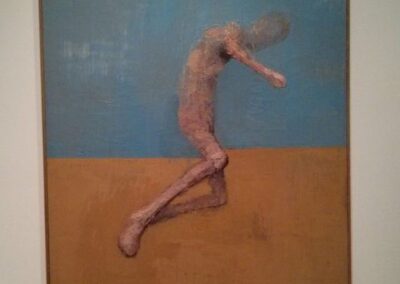The latest person we’re featuring in AIH’s ongoing Artists You Need To Know series has a work currently on display at the Art Gallery of Hamilton that is, perhaps, one of his finest, and a fine example of his practice. Graham Coughtry’s Leaping Figure (1961) is given pride of place, one might say, in the most recent exhibition of works from the AGH collection, exploring artists who were part of the Av Isaacs Gallery in Toronto. The large work contains all of the hallmarks that make Coughtry’s work so recognizable, and why his work with figures brings to mind the focused anarchy of paint that is seen in artists like Francis Bacon or Lucian Freud, who also approached the figure with emotion and energy. Coughtry (1931 – 1999) was educated at the Musée des beaux-arts de Montréal and the Ontario College of Art, a precursor of OCAD University.
-

Leaping Figure, 1961
-

Standing Figure, 1962
-

Danaë, 1989
-

Untitled, 1958
-

Portrait # 1, 1958
-

Figures Series #1, 1960
From his biography at James Rottman Gallery’s site: “The relationship of two figures had been one of the most persistent subjects of Graham Coughtry’s artistic career. These studies are not only charged with emotion, but also monumental in form. Coughtry was considered a gifted natural painter who had a great sense of colour and was able to bring something truly unique to figurative painting.” This is why, in the aforementioned selection of works at the AGH, with pieces by Nakamura, Ronald or Town, Coughtry stands out, with a unique sensibility, both in constructing a scene but in his use of paint and colour and texture.
-

Two figures series XIX, 1964
-

Afternoon Lovers - for Pablo Neruda, 1979
-

Self Portrait, 1963
-

Portrait #6, 1959
-

Two Figures, 1962
-

Reclining Figure Moving #10, 1980
Coughtry has exhibited at a number of significant spaces across North America and Europe, including the Centre Culturel Canadien, National Gallery of Canada, Albright-Knox, MoMA The Museum of Modern Art, La Biennale di Venezia, Solomon R. Guggenheim Museum, Art Gallery of Greater Victoria, Art Gallery of Windsor, MacKenzie Art Gallery, The Robert McLaughlin Gallery, and the AGO – Art Gallery of Ontario. His works can be found in many of those same collections. In terms of public spaces, Coughtry painted a mural at the Toronto International Airport in 1962.
As a teacher at the Ontario College of Art and Design, the New School of Art, and York University, he was a significant influence on generations of Toronto based painters, both through his pedagogy and practice.
“His national reputation was made with semi-abstract paintings that showed one or two figures floating in space, but, as he said, colour came first, along with heavy impasto. In some of the canvases the figure might be hardly perceptible.” (Wikipedia)











